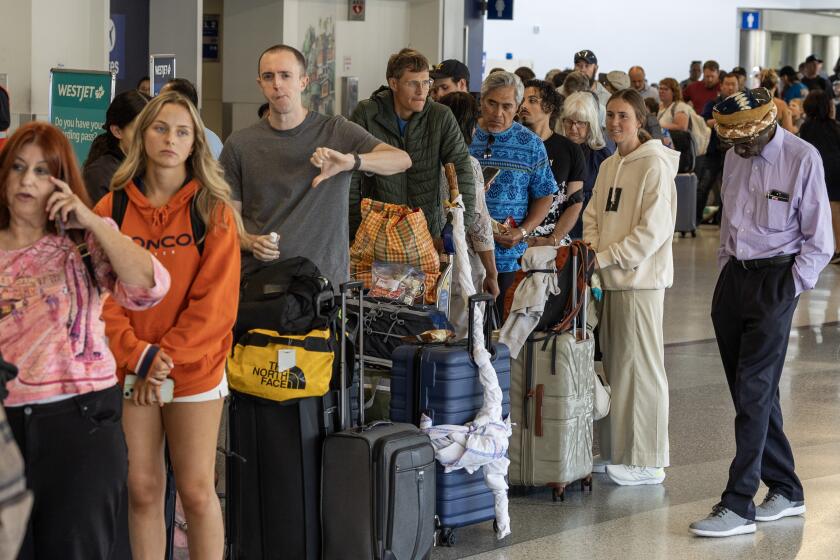Saccharin’s mostly sweet following
Think saccharin is unsafe? You may want to think again.
Saccharin was first identified as a hazardous, potentially cancer-causing chemical by the Food and Drug Administration in the 1970s. But since that time it has slowly been exonerated by state and federal agencies. The FDA changed its position on the chemical in 2001, reclassifying it as OK for consumption, as did the state of California. Now the EPA has announced removal of the sweetener from its list of hazardous chemicals too.
Saccharin is one of the best studied artificial sweeteners — after all, it’s been around the longest. It was discovered accidentally in the 1870s by a Johns Hopkins University scientist who was searching for a food preservative when he noticed that one of the compounds he was working with was terrifically sweet.
By 1900, saccharin had become popular among food manufacturers, who slipped it into products unannounced as a cheap alternative to sugar. When word got out about the practice, irate Americans demanded better food labeling laws to ensure they were getting what they paid for.
During World Wars I and II, when sugar was rationed, saccharin become popular among consumers. But its popularity wouldn’t surge until the 1950s, when dieting came into vogue and women, in particular, began casting about for low-calorie foods and ingredients. That’s when saccharin, until then available in drugstores as a sweetener for diabetics, began to make its way into kitchens and a growing number of diet foods, says Carolyn de la Peña, professor of American Studies at UC Davis and the author of “Empty Pleasures: The Story of Artificial Sweeteners From Saccharin to Splenda.”
From the 1950s through the 1960s, as dieting became more and more popular, saccharin and a second class of artificial sweeteners called cyclamates were added to everything from canned fruit to diet soda.
Both sweeteners became the targets of new federal laws in the 1970s, when the environmental movement focused Americans’ attention on the potential risks of synthetic chemicals, says David Rosner, professor of history and sociomedical sciences at Columbia University in New York.
In that decade, new studies examining the sweeteners’ effects on lab rats suggested that both cyclamates and saccharin increased the risk of bladder cancer. The FDA moved quickly to ban cyclamates in 1970, invoking a 1958 law that allowed the agency to restrict any food additive found to cause cancer in animals or people.
But when the agency attempted to do the same for saccharin in 1977, a million people wrote letters of protest, says De la Peña. She attributes the outcry to the fact that Americans were less trusting of government in the late 1970s — and to the fact that the Calorie Control Council, which represents the diet food and drink industry, ran an ad campaign encouraging consumers to protest the ban. (A petition by the Calorie Control Council was also behind the EPA’s recent review of the sweetener.) In response, the FDA required saccharin-containing foods to bear the following warning label instead: “Use of this product may be hazardous to your health. This product contains saccharin which has been determined to cause cancer in laboratory animals.”
Research on saccharin continued after the FDA declared it a hazardous chemical, and animal studies continued to link the sweetener to bladder cancer when ingested at high doses. But human studies were less conclusive.
A few European studies looked at populations who consumed artificial sweeteners back in the 1940s, when saccharin consumption was high, but these found no link between the sweetener and bladder cancer.
A large American study, conducted by the National Cancer Institute and published in the journal Epidemiology in 1994, found a 30% higher risk of bladder cancer in people who consumed more than 1.6 grams of artificial sweetener a day. (The study also found that having multiple urinary tract infections and drinking more than 50 cups of coffee a week increased the risk of cancer by roughly the same amount.)
These data led the Department of Health and Human Services’ National Toxicology Program to remove saccharin from its list of harmful carcinogens in 2000. The program’s scientists concluded that the doses that caused cancer in lab rats — saccharin made up 3% or more of their diets — were far higher than human consumption rates. Furthermore, they noted, saccharin caused cancer in rats by irritating the bladder, an effect considered irrelevant to humans because of the differences in urine composition between people and rats.
Following the National Toxicology Program’s decision, the FDA repealed the sweetener’s warning label. And when the EPA announced it would take saccharin off its list of hazardous chemicals in December, it too based its decision on the National Toxicology Program’s report.
But Marion Nestle, professor of nutrition, food studies and public health at New York University, says the safety of the sweetener is still up for debate.
“The science [on saccharin] has always been complicated, as is typical for substances used at low doses,” she says.
Rosner says that population studies of saccharin’s (or any chemical’s) effects on humans are inherently limited. Such studies, which look at the health effects of large numbers of people who choose to eat saccharin or not, can’t separate long-term effects of one sweetener from another, since people who consume artificial sweeteners don’t usually limit themselves to one type.
Rosner adds says that saccharin is caught up in a decades-old political battle over how to determine whether chemicals added to food and other products are safe over the long term. Historically, he says, industry has favored putting chemicals into use until their risks can be demonstrated — an event that rarely happens unless a chemical causes immediate or dramatic harm. Consumer groups have called for a precautionary approach that would require industries to prove chemicals are safe beyond a doubt before including them in foods or other consumer products.
Politics aside, whether saccharin or artificial sweeteners in general are safe is a separate question from whether they’re good for you, says Dr. Rebecca Brown, a pediatric endocrinologist with the National Institute of Diabetes and Digestive and Kidney Diseases at the National Institutes of Health.
Although decades of use and research indicate that the levels humans typically consume are unlikely to be toxic, saccharin and other artificial sweeteners may have other negative effects. For instance, Brown says, many studies have linked artificial sweetener consumption to increased weight gain and an increased risk of diabetes. Scientists still haven’t determined whether the sweeteners cause the weight gain and diabetes, or whether people who are at risk of overweight and diabetes are more likely to use such sweeteners to begin with.
For some, the sweetener’s bitterness may override other concerns. (“Personally, I do not like the way it tastes, and I avoid it when I can,” Nestle says.) But, says De la Peña, “if it were going to kill us, we’d know that by now.”
More to Read
Eat your way across L.A.
Get our weekly Tasting Notes newsletter for reviews, news and more.
You may occasionally receive promotional content from the Los Angeles Times.






